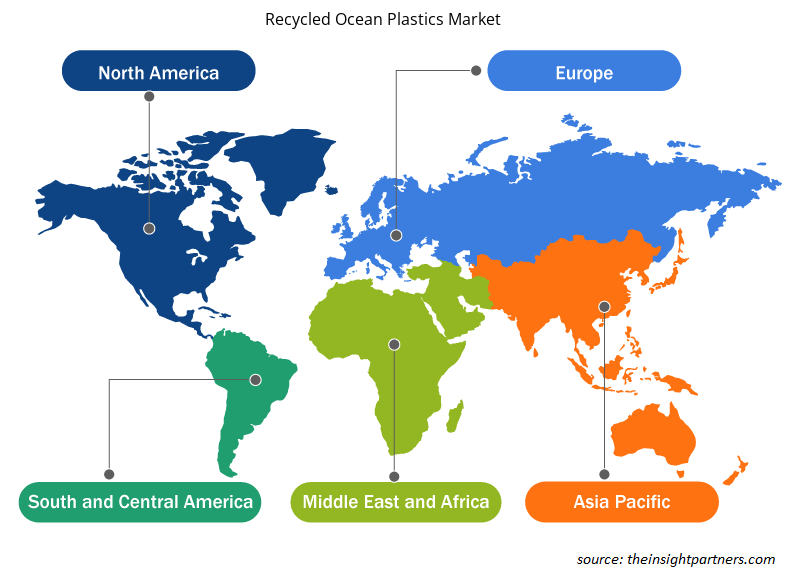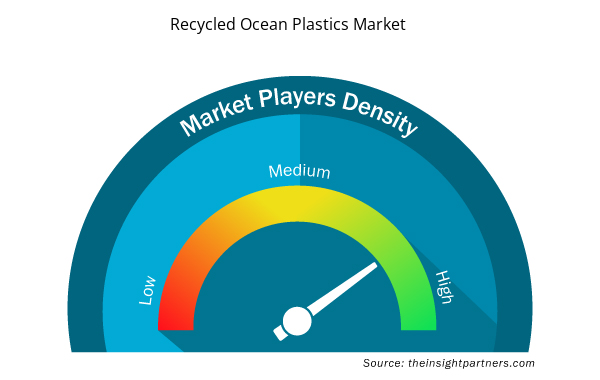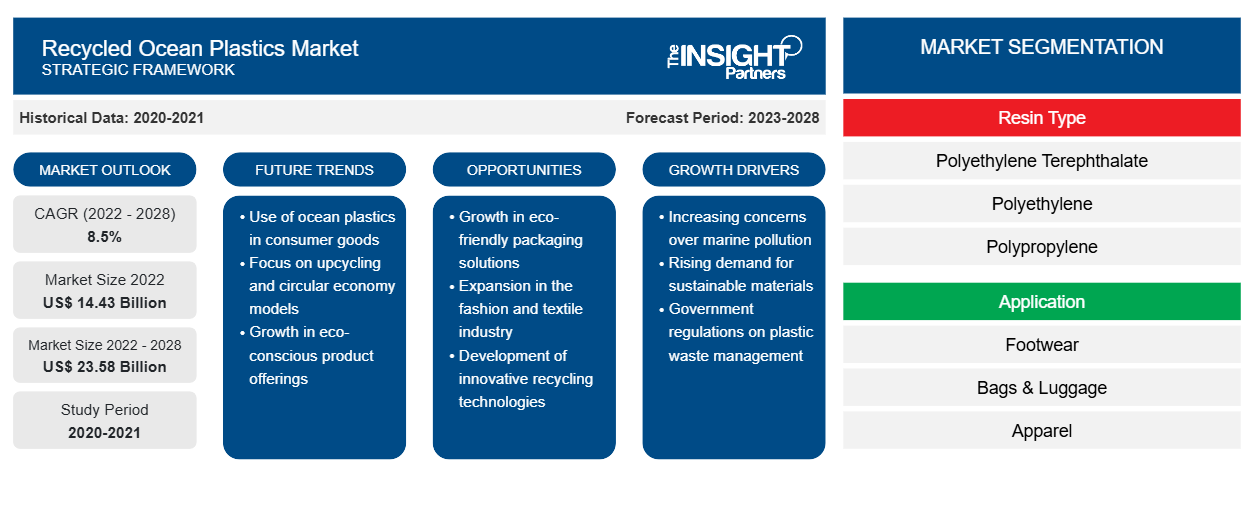Der Markt für recycelte Meeresplastikprodukte hatte im Jahr 2022 ein Volumen von 14.432,91 Millionen US-Dollar und dürfte von 2022 bis 2028 mit einer durchschnittlichen jährlichen Wachstumsrate von 8,5 % wachsen.CAGR of 8.5% from 2022 to 2028.
Die Verschmutzung durch Plastik ist aufgrund ihrer negativen Auswirkungen auf lebende Organismen eines der größten Probleme. Jedes Jahr werden Tonnen von Plastikmüll in Meere und Gewässer gekippt, was das marine Ökosystem schädigt. Daher konzentrieren sich Hersteller stark auf das Recycling von Plastikmüll aus den Ozeanen und die Herstellung nützlicher Produkte wie Schuhe, Taschen, Gepäck, Geldbörsen und Kleidung aus diesen Kunststoffen.
Im Jahr 2021 hatte der asiatisch-pazifische Raum den größten Umsatzanteil am globalen Markt für recycelte Meeresplastik . Der Markt im asiatisch-pazifischen Raum ist in Indien, China, Australien, Japan, Südkorea und den Rest des asiatisch-pazifischen Raums unterteilt. Das Wachstum des Marktes für recycelte Meeresplastik in der Region wird durch die schnell wachsende Modebranche, die steigende Bevölkerung und das steigende Bewusstsein der Verbraucher für nachhaltige Lösungen in der gesamten Region vorangetrieben. China und Indien gehören zu den Ländern mit der am schnellsten wachsenden Bevölkerung. Aufgrund der wachsenden Bevölkerung entwickeln sich die Schuh-, Verpackungs- und Bauindustrie in der Region rasant. Die wachsenden Initiativen der regionalen Hersteller, den CO2-Fußabdruck durch die Herstellung umweltfreundlicher Produkte zu reduzieren, treiben auch das Wachstum des Marktes für recycelte Meeresplastik in der Region an.
Passen Sie diesen Bericht Ihren Anforderungen an
Sie erhalten kostenlos individuelle Anpassungen an jedem Bericht, einschließlich Teilen dieses Berichts oder einer Analyse auf Länderebene, eines Excel-Datenpakets sowie tolle Angebote und Rabatte für Start-ups und Universitäten.
- Holen Sie sich die wichtigsten Markttrends aus diesem Bericht.Dieses KOSTENLOSE Beispiel umfasst eine Datenanalyse von Markttrends bis hin zu Schätzungen und Prognosen.
Auswirkungen der COVID-19-Pandemie auf den Markt für recyceltes Meeresplastik
Der steigende Bedarf an nachhaltigen und umweltfreundlichen Materialien in der Schuh-, Bekleidungs-, Verpackungs- und Bauindustrie trieb vor dem Ausbruch der COVID-19-Pandemiekrise die Nachfrage nach recyceltem Meeresplastik an. Im Jahr 2020 verhängten die Regierungen verschiedener Länder jedoch Ausgangssperren, um die Ausbreitung der SARS-CoV-2-Infektion einzudämmen, wodurch der Betrieb von Kunststoffrecyclinganlagen zum Erliegen kam und es zu einem Mangel an recyceltem Meeresplastik kam. Laut einem von GA Circular veröffentlichten Bericht waren in den ersten Monaten des Jahres 2020 80 % der Recyclinganlagen in Indien, Vietnam und den Philippinen geschlossen, was zu einem erheblichen Mangel an recyceltem Plastik führte . Dies hatte negative Auswirkungen auf das Wachstum des Marktes für recyceltes Meeresplastik.
Im Jahr 2021 nahmen viele Volkswirtschaften ihren Betrieb wieder auf. Die Regierungen verschiedener Länder lockerten die zuvor verhängten Beschränkungen und erlaubten den Herstellern, mit voller Kapazität zu arbeiten. Dieser Faktor wirkte sich positiv auf die Kunststoffrecyclingaktivitäten aus. Viele Regierungen und NGOs bauen eine robuste Abfallwirtschaftsinfrastruktur auf, um die Kreislaufwirtschaft zu unterstützen und die Bedrohung der Meeresökosysteme durch Plastikmüll zu minimieren. Dieser Faktor wird die Nachfrage nach recyceltem Meeresplastik im Prognosezeitraum ankurbeln.
Markteinblicke
Zunehmende Markteinführung von Produkten aus recyceltem Meeresplastik
Die Verschmutzung der Meere durch Plastik ist eine dringende globale Herausforderung, da sie eine erhebliche Bedrohung für lebende Organismen darstellt. Laut den Statistiken des Ocean Literacy Portals der Organisation der Vereinten Nationen für Erziehung, Wissenschaft und Kultur macht Plastikmüll etwa 80 % der gesamten Meeresverschmutzung aus, und jedes Jahr landen etwa 8–10 Millionen Tonnen Plastik im Meer. Darüber hinaus wird erwartet, dass die Menge an Mikroplastik in den Ozeanen in Zukunft deutlich ansteigen wird. Dennoch ist das Bewusstsein für die Verschmutzung der Meere durch Plastik in vielen Ländern gestiegen, und Regierungen und Regulierungsbehörden ergreifen Initiativen zum Recycling dieser Kunststoffe. Viele Unternehmen bringen innovative und attraktive Produkte auf den Markt, darunter Schuhe, Handtaschen und Geldbörsen, Sonnenbrillen und Bekleidung, die recyceltes Meeresplastik verwenden, um ihre Nachhaltigkeitsziele zu erreichen und ihren gesamten ökologischen Fußabdruck zu verringern. All diese genannten Faktoren treiben das Wachstum des Marktes für recyceltes Meeresplastik voran.
Einblicke in den Harztyp
Basierend auf dem Harztyp ist der globale Markt für recycelte Meereskunststoffe in Polyethylenterephthalat (PET) , Polyethylen (PE), Polypropylen (PP), Polystyrol (PS) und andere unterteilt. Das Segment Polyethylenterephthalat hatte 2021 den größten Marktanteil. Die einfache Gewinnung von Polyethylenterephthalat (PET) aus Ozeanen und Wasserstraßen aufgrund seines höheren Gewichts und seiner Fähigkeit, seine Form zu behalten, fördert das Marktwachstum in diesem Segment. Darüber hinaus treibt die steigende Nachfrage nach recyceltem Meeres-PET für Taschen, Gepäck und Schuhe das Marktwachstum in der Region an.
Anwendungseinblicke
Basierend auf der Anwendung ist der globale Markt für recyceltes Meeresplastik in Schuhe, Taschen und Gepäck, Bekleidung, Baumaterialien und andere unterteilt. Das Bekleidungssegment hatte 2021 den größten Marktanteil. Die steigende Nachfrage der Modebranche nach Bekleidung und die wachsende Weltbevölkerung werden voraussichtlich in den kommenden Jahren den Bedarf an recyceltem Meeresplastik in der Textilindustrie ankurbeln.
Aquafil SpA; BIONIC; Tide Ocean SA; Oceanworks; Textil Santanderina; Envision Plastics; OceanYarn; Waste2Wear; Unifi, Inc.; und SABIC gehören zu den Akteuren auf dem Markt für recycelte Meeresplastik. Diese Unternehmen investieren erheblich in Forschung und Entwicklung, um innovative Produkte zu entwickeln, die den neuen Verbraucheranforderungen gerecht werden. Die Marktteilnehmer konzentrieren sich darauf, qualitativ hochwertige Produkte anzubieten, um die Kundennachfrage zu erfüllen.
Regionale Einblicke in den Markt für recycelte Meeresplastik
Die regionalen Trends und Faktoren, die den Markt für recycelte Meeresplastik im Prognosezeitraum beeinflussen, wurden von den Analysten von Insight Partners ausführlich erläutert. In diesem Abschnitt werden auch die Marktsegmente und die Geografie für recycelte Meeresplastik in Nordamerika, Europa, im asiatisch-pazifischen Raum, im Nahen Osten und Afrika sowie in Süd- und Mittelamerika erörtert.

- Erhalten Sie regionale Daten zum Markt für recycelte Meeresplastik
Umfang des Marktberichts über recycelte Meereskunststoffe
| Berichtsattribut | Details |
|---|---|
| Marktgröße im Jahr 2022 | 14,43 Milliarden US-Dollar |
| Marktgröße bis 2028 | 23,58 Milliarden US-Dollar |
| Globale CAGR (2022 - 2028) | 8,5 % |
| Historische Daten | 2020-2021 |
| Prognosezeitraum | 2023–2028 |
| Abgedeckte Segmente | Nach Harztyp
|
| Abgedeckte Regionen und Länder | Nordamerika
|
| Marktführer und wichtige Unternehmensprofile |
|
Marktteilnehmerdichte für recyceltes Meeresplastik: Auswirkungen auf die Geschäftsdynamik verstehen
Der Markt für recycelte Meeresplastikprodukte wächst rasant. Dies wird durch die steigende Nachfrage der Endverbraucher aufgrund von Faktoren wie sich entwickelnden Verbraucherpräferenzen, technologischen Fortschritten und einem größeren Bewusstsein für die Vorteile des Produkts vorangetrieben. Mit der steigenden Nachfrage erweitern Unternehmen ihr Angebot, entwickeln Innovationen, um die Bedürfnisse der Verbraucher zu erfüllen, und nutzen neue Trends, was das Marktwachstum weiter ankurbelt.
Die Marktteilnehmerdichte bezieht sich auf die Verteilung der Firmen oder Unternehmen, die in einem bestimmten Markt oder einer bestimmten Branche tätig sind. Sie gibt an, wie viele Wettbewerber (Marktteilnehmer) in einem bestimmten Marktraum im Verhältnis zu seiner Größe oder seinem gesamten Marktwert präsent sind.
Die wichtigsten Unternehmen auf dem Markt für recycelte Meeresplastik sind:
- Aquafil SpA
- BIONIC
- Tide Ocean SA
- Ozeanwerke
- Textil Santanderina
Haftungsausschluss : Die oben aufgeführten Unternehmen sind nicht in einer bestimmten Reihenfolge aufgeführt.

- Überblick über die wichtigsten Akteure auf dem Markt für recycelte Meeresplastik
Bericht-Spotlights
- Fortschrittliche Branchentrends auf dem Markt für recycelte Meeresplastik sollen den Akteuren bei der Entwicklung wirksamer langfristiger Strategien helfen
- In Industrie- und Entwicklungsländern angewandte Strategien für Unternehmenswachstum
- Quantitative Analyse des Marktes für recyceltes Meeresplastik von 2020 bis 2028
- Schätzung der weltweiten Nachfrage nach recyceltem Meeresplastik
- Porters Fünf-Kräfte-Analyse zur Veranschaulichung der Wirksamkeit der in der Branche tätigen Käufer und Lieferanten
- Aktuelle Entwicklungen zum Verständnis des wettbewerbsorientierten Marktszenarios
- Markttrends und -aussichten sowie Faktoren, die das Wachstum des Marktes für recycelte Meereskunststoffe vorantreiben und bremsen
- Unterstützung im Entscheidungsprozess durch Hervorhebung von Marktstrategien, die das kommerzielle Interesse untermauern und zum Wachstum des Marktes für recycelte Meereskunststoffe führen
- Die Größe des Marktes für recyceltes Meeresplastik an verschiedenen Knotenpunkten
- Detaillierte Übersicht und Segmentierung des Marktes sowie der Dynamik der recycelten Meeresplastikindustrie
- Größe des Marktes für recyceltes Meeresplastik in verschiedenen Regionen mit vielversprechenden Wachstumschancen
Globaler Markt für recyceltes Meeresplastik
Der globale Markt für recycelte Meereskunststoffe ist nach Harztyp in Polyethylenterephthalat (PET), Polyethylen (PE), Polypropylen (PP), Polystyrol (PS) und andere unterteilt. Nach Anwendung ist der Markt in Schuhe, Taschen und Gepäck, Bekleidung, Baumaterialien und andere unterteilt.
Firmenprofile
- Aquafil SpA
- BIONIC
- Tide Ocean SA
- Ozeanwerke
- Textil Santanderina
- Kunststoffe von Envision
- Stofffeeling
- Waste2Wear
- Unifi, Inc.
- Sabic amon
- Historische Analyse (2 Jahre), Basisjahr, Prognose (7 Jahre) mit CAGR
- PEST- und SWOT-Analyse
- Marktgröße Wert/Volumen – Global, Regional, Land
- Branche und Wettbewerbsumfeld
- Excel-Datensatz



Report Coverage
Revenue forecast, Company Analysis, Industry landscape, Growth factors, and Trends

Segment Covered
This text is related
to segments covered.

Regional Scope
North America, Europe, Asia Pacific, Middle East & Africa, South & Central America

Country Scope
This text is related
to country scope.
Häufig gestellte Fragen
Asia Pacific is estimated to register the fastest CAGR in the global recycled ocean plastics market over the forecast period. Many APAC countries, such as China and India, are the world's fastest-growing populations. With a growing population, apparel, footwear, bags and luggage, construction material, and others are growing rapidly in APAC. The apparel industry is expanding in the APAC region because of growing population. The presence of established sectors, such as footwear and construction, in nations such as China, India, Japan, and South Korea has increased the demand for recycled ocean plastics in the region.
The apparel segment held the largest share of the market in 2022. The apparel sector has been experiencing robust growth due to lifestyle changes, growing urban population, and shift in consumer preferences. These factors drive the demand for recycled ocean plastic in the apparel industry. Furthermore, growing trend of recycled fashion, and the ability of plastic to be recycled is boosting the market growth in the apparel industry.
The footwear segment held the largest market share. Footwear is the most recycled post-consumer plastics. Use of recycled ocean plastic in shoe making can help reduce plastic waste and make footwear sustainable. Ethical footwear brands are taking initiatives against plastic waste by creating shoes made from recycled ocean plastic.
The polyethylene terephthalate segment held the largest market share. It is a polymer created by combining two monomers: modified ethylene glycol and purified terephthalic acid. Polyethylene terephthalate is the most widely used plastic; it is clear, strong, lightweight, and 100% recyclable. Polyethylene recycled plastics can be identified by recycling code#1; as they have a short lifespan, it is easy to recycle them.
The major players operating in the global recycled ocean plastics market are Aquafil S.p.A.; BIONIC; Tide Ocean SA; Oceanworks; Textil Santanderina; Envision Plastics; OceanYarn; Waste2Wear; Unifi, Inc.; and SABIC.
In 2022, Asia Pacific held the largest share of the global recycled ocean plastics market. The rise in the number of textile industries would cater the demand of recycled ocean plastics in the region. The region is also flourishing owing to presence of manufacturing facilities and cheap labor.
The List of Companies - Recycled Ocean Plastics Market
- Aquafil S.p.A.
- BIONIC
- Tide Ocean SA
- Oceanworks
- Textil Santanderina
- Envision Plastics
- OceanYarn
- Waste2Wear
- Unifi, Inc.
- SABIC
The Insight Partners performs research in 4 major stages: Data Collection & Secondary Research, Primary Research, Data Analysis and Data Triangulation & Final Review.
- Data Collection and Secondary Research:
As a market research and consulting firm operating from a decade, we have published and advised several client across the globe. First step for any study will start with an assessment of currently available data and insights from existing reports. Further, historical and current market information is collected from Investor Presentations, Annual Reports, SEC Filings, etc., and other information related to company’s performance and market positioning are gathered from Paid Databases (Factiva, Hoovers, and Reuters) and various other publications available in public domain.
Several associations trade associates, technical forums, institutes, societies and organization are accessed to gain technical as well as market related insights through their publications such as research papers, blogs and press releases related to the studies are referred to get cues about the market. Further, white papers, journals, magazines, and other news articles published in last 3 years are scrutinized and analyzed to understand the current market trends.
- Primary Research:
The primarily interview analysis comprise of data obtained from industry participants interview and answers to survey questions gathered by in-house primary team.
For primary research, interviews are conducted with industry experts/CEOs/Marketing Managers/VPs/Subject Matter Experts from both demand and supply side to get a 360-degree view of the market. The primary team conducts several interviews based on the complexity of the markets to understand the various market trends and dynamics which makes research more credible and precise.
A typical research interview fulfils the following functions:
- Provides first-hand information on the market size, market trends, growth trends, competitive landscape, and outlook
- Validates and strengthens in-house secondary research findings
- Develops the analysis team’s expertise and market understanding
Primary research involves email interactions and telephone interviews for each market, category, segment, and sub-segment across geographies. The participants who typically take part in such a process include, but are not limited to:
- Industry participants: VPs, business development managers, market intelligence managers and national sales managers
- Outside experts: Valuation experts, research analysts and key opinion leaders specializing in the electronics and semiconductor industry.
Below is the breakup of our primary respondents by company, designation, and region:

Once we receive the confirmation from primary research sources or primary respondents, we finalize the base year market estimation and forecast the data as per the macroeconomic and microeconomic factors assessed during data collection.
- Data Analysis:
Once data is validated through both secondary as well as primary respondents, we finalize the market estimations by hypothesis formulation and factor analysis at regional and country level.
- Macro-Economic Factor Analysis:
We analyse macroeconomic indicators such the gross domestic product (GDP), increase in the demand for goods and services across industries, technological advancement, regional economic growth, governmental policies, the influence of COVID-19, PEST analysis, and other aspects. This analysis aids in setting benchmarks for various nations/regions and approximating market splits. Additionally, the general trend of the aforementioned components aid in determining the market's development possibilities.
- Country Level Data:
Various factors that are especially aligned to the country are taken into account to determine the market size for a certain area and country, including the presence of vendors, such as headquarters and offices, the country's GDP, demand patterns, and industry growth. To comprehend the market dynamics for the nation, a number of growth variables, inhibitors, application areas, and current market trends are researched. The aforementioned elements aid in determining the country's overall market's growth potential.
- Company Profile:
The “Table of Contents” is formulated by listing and analyzing more than 25 - 30 companies operating in the market ecosystem across geographies. However, we profile only 10 companies as a standard practice in our syndicate reports. These 10 companies comprise leading, emerging, and regional players. Nonetheless, our analysis is not restricted to the 10 listed companies, we also analyze other companies present in the market to develop a holistic view and understand the prevailing trends. The “Company Profiles” section in the report covers key facts, business description, products & services, financial information, SWOT analysis, and key developments. The financial information presented is extracted from the annual reports and official documents of the publicly listed companies. Upon collecting the information for the sections of respective companies, we verify them via various primary sources and then compile the data in respective company profiles. The company level information helps us in deriving the base number as well as in forecasting the market size.
- Developing Base Number:
Aggregation of sales statistics (2020-2022) and macro-economic factor, and other secondary and primary research insights are utilized to arrive at base number and related market shares for 2022. The data gaps are identified in this step and relevant market data is analyzed, collected from paid primary interviews or databases. On finalizing the base year market size, forecasts are developed on the basis of macro-economic, industry and market growth factors and company level analysis.
- Data Triangulation and Final Review:
The market findings and base year market size calculations are validated from supply as well as demand side. Demand side validations are based on macro-economic factor analysis and benchmarks for respective regions and countries. In case of supply side validations, revenues of major companies are estimated (in case not available) based on industry benchmark, approximate number of employees, product portfolio, and primary interviews revenues are gathered. Further revenue from target product/service segment is assessed to avoid overshooting of market statistics. In case of heavy deviations between supply and demand side values, all thes steps are repeated to achieve synchronization.
We follow an iterative model, wherein we share our research findings with Subject Matter Experts (SME’s) and Key Opinion Leaders (KOLs) until consensus view of the market is not formulated – this model negates any drastic deviation in the opinions of experts. Only validated and universally acceptable research findings are quoted in our reports.
We have important check points that we use to validate our research findings – which we call – data triangulation, where we validate the information, we generate from secondary sources with primary interviews and then we re-validate with our internal data bases and Subject matter experts. This comprehensive model enables us to deliver high quality, reliable data in shortest possible time.


 Holen Sie sich ein kostenloses Muster für diesen Bericht
Holen Sie sich ein kostenloses Muster für diesen Bericht